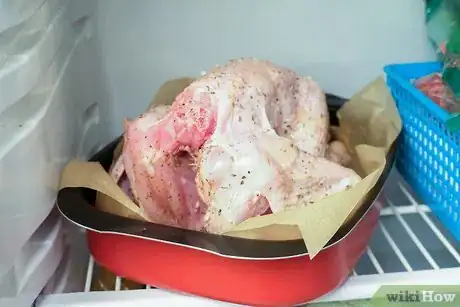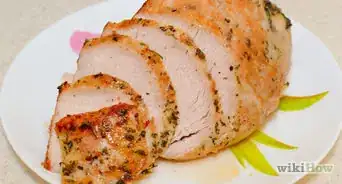This article was co-authored by JoAnna Minneci and by wikiHow staff writer, Jessica Gibson. JoAnna Minneci is a Professional Chef based in the Nashville, Tennessee area. With more than 18 years of experience, Chef JoAnna specializes in teaching others how to cook through private cooking lessons, team-building events, and wellness and nutrition classes. She has also appeared in numerous television shows on networks such as Bravo and Food Network. Chef JoAnna received Culinary Arts training from the Art Institute of California at Los Angeles. She is also certified in sanitation, nutrition, kitchen management, and cost control.
There are 9 references cited in this article, which can be found at the bottom of the page.
This article has been viewed 7,925 times.
There are countless ways to cook a turkey, but a few methods give fantastic results every time. Skip the messy saltwater solution and opt for a dry brine if you want to give your bird incredible flavor and you've got time to spare. If you'd rather season the turkey to make it last longer after you smoke it, you do need to submerge it in a special saltwater solution before you cook it. Either way, you'll have a memorable meal that's packed with flavor.
Ingredients
- 3 tablespoons (54 g) of kosher salt
- 1 1/2 teaspoons (3 g) of dried herbs, like thyme, sage, and rosemary, or a blend
- 3/4 teaspoon (1.5 g) of freshly ground black pepper
- 14 to 16 lb (6.4 to 7.3 kg) whole turkey, thawed
- 3 tablespoons (36 g) of light brown sugar, optional
Makes 1 roasted turkey
- 1 gallon (3.8 L) of cold water
- 1.6 ounces (100 g) of saltpeter or cure that contains 6.25% sodium nitrate
- 1 pound (450 g) of non-iodized salt
- 2.4 ounces (68 g) of brown or white sugar
- 14 to 16 lb (6.4 to 7.3 kg) whole turkey, thawed
Makes 1 smoked turkey
Steps
Dry-Brine
-
1Thaw your turkey in the fridge 3 to 4 days before you want to cure it. Turkeys take a long time to defrost! Plan on transferring a 14 to 16 lb (6.4 to 7.3 kg) whole turkey from the freezer to the fridge at least 3 days before you cure it. You don't have to take it out of the package—just toss it straight into the fridge to thaw.[1]
- Check the label to see that the turkey hasn't been brined or salted since you'll be seasoning it yourself.
-
2Unwrap the thawed turkey and remove the giblets. Once your turkey is thawed, take it out of the packaging and set it on a platter or cutting board. Remove any plastic or metal cages that are wrapped around the feet and pull out the pop-up thermometer. Then, reach inside the cavity and take out the bag of giblets.[2]
- If you can't find the giblets, don't worry. Some turkeys might not include them.
- Save the giblets if you want to use them in gravy or stock.
Advertisement -
3Pat the turkey with a paper towel and use your fingers to loosen the skin. Tear off a paper towel and press it over the turkey skin to get rid of moisture. Then, push your fingers under the skin on the breast and slide your hand along the meat so the skin loosens. Loosen the skin on the legs too.[3]
- You're creating space for the dry brine so it flavors the turkey better.
-
4Mix the salt, herbs, and pepper in a small bowl. The seasoning you use is customizable but start with putting 3 tablespoons (54 g) of kosher salt into a bowl along with 3/4 teaspoon (1.5 g) of freshly ground black pepper. Then, stir in 1 1/2 teaspoons (3 g) of dried herbs. You can use a single herb like thyme, sage, or rosemary, or use a blend that equals 1 1/2 teaspoons (3 g).[4]
- If you want a rich, slightly sweet flavor, add 3 tablespoons (36 g) of light brown sugar. The sugar caramelized a little so your turkey has a deep, sweet-salty flavor.
- Want to use fresh herbs? Great— just use 1 tablespoon (2.5 g) of finely chopped fresh herbs instead of the dried herbs.
- Experiment with other herb combinations. For example, mix equal parts kosher salt with dried marjoram, dried thyme, dried and ground juniper berries. Then, mix in 1/3 part of ground pepper.
-
5Season the cavity and the turkey meat with the dry brine. You can eyeball the amount or measure out 2 teaspoons (5 g) of the dry brine. Put this into the cavity of the turkey. Then, rub about 2 teaspoons (5 g) of the brine onto the meat of the legs and work 4 teaspoons (10 g) of the brine onto the breast meat under the loosened skin.[5]
- Try to work evenly so both sides of the turkey get the same amount of dry brine.
-
6Put the turkey in a roasting dish and tuck the wings under the breast. Set the seasoned turkey in a dish that's big enough to hold the bird, but that will also fit into your fridge. Bend the turkey's wings back and under the breast so they'll cook evenly later.[6]
- If you have a really big turkey and are struggling to get the wings tucked back, you may want to truss the bird. This means that you use kitchen twine to secure the legs and wings to the body.
- Since the breasts take a long time to cook, put your turkey breast-side up in the pan so they cook faster.
-
7Refrigerate the turkey for up to 3 days. You don't have to wrap the turkey with plastic wrap, but you can place a large overturned bowl on the turkey so things don't fall on it in your fridge. Chill the turkey for at least 1 day and up to 3 so the salt and seasonings penetrate the meat.[7]
- Don't have 3 days to wait? Cure the bird for a minimum of 1 day before you cook it.
-
8Roast, grill, fry, or smoke your dry-cured turkey. The great thing about a dry brine is that you can still use your preferred cooking method. Grill the turkey or use your smoker for an extra level of flavor or roast it in the oven for a classic way to cook the turkey. Feeling adventurous? Deep-fry your turkey to get amazing crispy skin.[8]
- Always cook your turkey to an internal temperature of 165 °F (74 °C), regardless of which cooking method you choose.
- Store leftover cooked turkey in an airtight container in the fridge for up to 4 days.
Smoke Cure
-
1Put a frozen turkey into the fridge for about 3 days to thaw. Buy a 14 to 16 lb (6.4 to 7.3 kg) whole turkey that hasn't been brined or pre-treated with salt. About a week before you're ready to smoke the turkey, transfer the frozen turkey to the fridge so it has time to thaw before you cure it.[9]
- Plan on 3 days to thaw plus 3 days for curing.
-
2Pour 1 US gal (3.8 L) of cold water into a 5 US gal (19 L) food-safe cooler. When you're ready to cure, pour the cold water into a cooler. If you don't have a cooler, you can use the largest pot you have that will hold the turkey and fit in your fridge.[10]
- Don't forget to make space in your fridge! You may have to lower shelves to fit a large pot or cooler.
-
3Mix saltpeter or cure, salt, and sugar into the water until they dissolve. Get out a kitchen scale and measure your brine ingredients. Pour 1.6 ounces (100 g) of saltpeter or a cure that contains 6.25% sodium nitrate, 1 pound (450 g) of non-iodized salt, and 2.4 ounces (68 g) of brown or white sugar into the cold water. Then, stir or whisk vigorously until the ingredients dissolve and your brine is clear.[11]
- Feel like playing with the seasonings? Stir in 1 teaspoon (2 g) of ground black pepper, 1 tablespoon (3.5 g) of dried rosemary, 1 1/2 tablespoons (3 g) of dried sage, or 1 1/2 tablespoons (6.5 g) of dried thyme.
- To give your turkey a fresher, flavorful taste, add a few bay leaves, orange peels, or lemon peels to the brine after you dissolve the salt.
- Saltpeter is also called "cure" and you can buy it in the meat department, at butcher shops, or online. The sodium nitrate in the saltpeter or cure is what gives the turkey a light pink color after you smoke it.
-
4Remove the turkey from the package and take out the giblets. Take the thawed turkey out of the fridge and get it out of the package. Then, set the turkey on a rimmed baking sheet and pull out the pop-up thermometer—you won't need to to cook the turkey. Don't forget to take out the giblets from the cavity of the bird. You can discard them or save them to make gravy.[12]
- If the legs have been held together with metal or plastic, remove it.
-
5Use a meat injector to inject brine into the meat of the turkey. Fill the injector full of brine and stick the needle into a breast. Squeeze the plunger to inject 45 cc of the brine. Then, pull the needle out a little and angle the needle in a different direction. Squeeze another 45 cc into the breast. Repeat this for the other breast, both of the thighs, and the drumsticks.[13]
- Use 45 cc of brine for every 1 pound (450 g) of meat.
- You can buy meat injectors at some grocery stores, meat departments, or online.
-
6Put the turkey into the container so it's submerged in brine. Take your brine-injected bird and put it into the large container or pot with the the brine. 1 gallon (3.8 L) of brine should be enough to cover your turkey.[14]
- Can't get your turkey to stay submerged? Don't worry— place a heavy plate or dish on top of the turkey to weigh it down.
-
7Keep the turkey under 40 °F (4 °C) and cure it for 2 to 3 days. Put the container into the fridge and leave the bird to cure for at least 2 days. The longer you cure it, the deeper the flavor will be. If you're using a cooler that you can't fit into the fridge, check the temperature several times throughout the day to see that it's between 36 and 40 °F (2 and 4 °C).[15]
- If you have to make the cooler colder, you can add a small amount of ice. Try not to put a lot in or you might weaken the brine solution.
-
8Smoke the turkey so the meat reaches 165 °F (74 °C). Heat your smoker to 170 °F (77 °C) and remove the bird from the brine. Place it in your smoker and cook it for 6 to 10 hours or until the turkey's skin turns as brown as you like. Then, turn up the smoker temperature to 200 °F (93 °C) and smoke the turkey until it reaches 165 °F (74 °C) with an instant-read meat thermometer.[16]
- Use flavorful smokes to cook your turkey, like cherry wood or apple wood.
- The total amount of time it takes to smoke the turkey depends on the weight of your turkey. In general, plan on 25 to 30 minutes per 1 pound (450 g) of meat.
- Since you used sodium nitrate to cure the turkey, you can refrigerate leftovers in an airtight container for up to 3 weeks.
Warnings
- It's really important to get a turkey that's not kosher or pre-salted since you're adding salt when you cure it.⧼thumbs_response⧽
- The USDA advises against rinsing your turkey since doing so can actually splash bacteria onto your work surfaces.[17]⧼thumbs_response⧽
Things You'll Need
Dry-Brine
- Measuring spoons
- Small bowl
- Paper towels
- Spoon
- Roasting dish
- Instant-read meat thermometer
- Cutting board and carving knife
Smoke Cure
- Measuring cups and spoons
- Large pot
- Kitchen scale
- Spoon
- 5 US gal (19 L) food-safe cooler or bucket with lid
- Turkey meat injector
- Baking sheet
- Smoker
- Paper towels
- Instant-read meat thermometer
- Oven mitts
References
- ↑ https://www.usda.gov/media/blog/2016/11/18/how-safely-thaw-turkey
- ↑ https://www.sunset.com/recipe/dry-cured-rosemary-turkey
- ↑ https://www.thekitchn.com/how-to-dry-brine-a-turkey-cooking-lessons-from-the-kitchn-212426
- ↑ https://www.thekitchn.com/how-to-dry-brine-a-turkey-cooking-lessons-from-the-kitchn-212426
- ↑ https://www.thekitchn.com/how-to-dry-brine-a-turkey-cooking-lessons-from-the-kitchn-212426
- ↑ https://www.thekitchn.com/how-to-dry-brine-a-turkey-cooking-lessons-from-the-kitchn-212426
- ↑ https://www.sunset.com/recipe/dry-cured-rosemary-turkey
- ↑ https://www.thekitchn.com/how-to-dry-brine-a-turkey-cooking-lessons-from-the-kitchn-212426
- ↑ https://www.usda.gov/media/blog/2016/11/18/how-safely-thaw-turkey
- ↑ https://www.thekitchn.com/how-to-brine-a-turkey-225751
- ↑ https://agrilifeextension.tamu.edu/library/health-nutrition/curing-and-smoking-poultry/
- ↑ https://www.sunset.com/recipe/dry-cured-rosemary-turkey
- ↑ https://www.recipetips.com/kitchen-tips/t--1043/flavor-injecting-turkey.asp
- ↑ https://www.usda.gov/media/blog/2017/11/16/brining-safely-will-bring-tender-flavorful-meat-thanksgiving-table
- ↑ https://agrilifeextension.tamu.edu/library/health-nutrition/curing-and-smoking-poultry/
- ↑ https://extension.oregonstate.edu/sites/default/files/documents/8836/sp50693curingandsmokingpoultrymeat.pdf
- ↑ https://www.usda.gov/media/blog/2013/11/21/wash-or-not-wash-your-turkey

























































